Numerical Study on the Characteristics of Boger Type Viscoelastic Fluid Flow in a Micro Cross-Slot under Sinusoidal Stimulation
Abstract
:1. Introduction
2. Methods
2.1. Physical Model
2.2. Governing Equations of Viscoelastic Fluid Flow
2.3. Numerical Methods
2.4. Boundary Conditions
2.5. Grid Independence Validation
3. Results and Discussion
3.1. Flow Pattern and DQ
3.1.1. Constant Inlet Velocity Condition
3.1.2. Sinusoidal Varying Inlet Velocity Condition
3.2. Time Domain Analysis
3.3. Frequency Domain Analysis
4. Conclusions
- (1)
- From the view of bifurcation parameter DQ, the flow pattern in micro cross-slot is time-dependent, but remains symmetric in space.
- (2)
- When the stimulation frequency is far away from the natural frequency of the viscoelastic fluid, the frequency spectrum of velocity fluctuation field shows the characteristics of a fundamental frequency and several harmonics. However, when the stimulation frequency is close to the natural frequency, a resonance phenomenon occurs, characterized by only one fundamental frequency and the disappearance of most harmonic frequencies.
- (3)
- The decay exponent of PSD of instantaneous velocity is between −2.31 and −1.98.
Author Contributions
Funding
Conflicts of Interest
References
- Groisman, A.; Steinberg, V. Efficient Mixing at Low Reynolds Numbers Using Polymer Additives. Nature 2001, 410, 905–908. [Google Scholar] [CrossRef] [PubMed] [Green Version]
- Tatsumi, K.; Takeda, Y.; Suga, K.; Nakabe, K. Turbulence characteristics and mixing performances of viscoelastic fluid flow in a serpentine microchannel. In Proceedings of the 13th European Turbulence Conference (ETC 13), Warsaw, Poland, 12–15 September 2011; p. 318. [Google Scholar] [CrossRef] [Green Version]
- Cai, W.H.; Li, Y.Y.; Zhang, H.N.; Li, Y.K.; Cheng, J.P.; Li, X.B.; Li, F.C. An Efficient Micro-Mixer by Elastic Instabilities of Viscoelastic Fluids: Mixing Performance and Mechanistic Analysis. Int. J. Heat Fluid Flow 2018, 74, 130–143. [Google Scholar] [CrossRef]
- Abed, W.M.; Whalley, R.D.; Dennis, D.J.C.; Poole, R.J. Experimental Investigation of the Impact of Elastic Turbulence on Heat Transfer in a Serpentine Channel. J. Non-Newton. Fluid Mech. 2016, 231, 68–78. [Google Scholar] [CrossRef] [Green Version]
- Li, D.Y.; Li, X.B.; Zhang, H.N.; Li, F.C.; Qian, S.Z.; Joo, S.W. Efficient Heat Transfer Enhancement by Elastic Turbulence with Polymer Solution in a Curved Microchannel. Microfluid. Nanofluid. 2017, 21, 10. [Google Scholar] [CrossRef]
- Groisman, A.; Enzelberger, M.; Quake, S.R. Microfluidic Memory and Control Devices. Science 2003, 300, 955–958. [Google Scholar] [CrossRef] [Green Version]
- Groisman, A.; Quake, S.R. A Microfluidic Rectifier: Anisotropic Flow Resistance at Low Reynolds Numbers. Phys. Rev. Lett. 2004, 92, 094501. [Google Scholar] [CrossRef] [Green Version]
- Li, Y.K.; Zhang, H.N.; Li, Y.Y.; Li, X.B.; Wu, J.; Qian, S.Z.; Li, F.C. Dynamic Control of Particle Separation in Deterministic Lateral Displacement Separator with Viscoelastic Fluids. Sci. Rep. 2018, 8, 3618. [Google Scholar] [CrossRef]
- Lu, X.Y.; Liu, C.; Hu, G.Q.; Xuan, X.C. Particle Manipulations in non-Newtonian Microfluidics: A Review. J. Colloid Interface Sci. 2017, 500, 182–201. [Google Scholar] [CrossRef] [Green Version]
- Adamatzky, A. A Brief History of Liquid Computers. Philos. Trans. R. Soc. B Biol. Sci. 2019, 374, 20180372. [Google Scholar] [CrossRef] [Green Version]
- Larson, R.G. Instabilities in Viscoelastic Flows. Rheol. Acta 1992, 31, 213–263. [Google Scholar] [CrossRef]
- Shaqfeh, E.S.G. Purely Elastic Instabilities in Viscometric Flows. Annu. Rev. Fluid Mech. 1996, 28, 129–185. [Google Scholar] [CrossRef]
- Groisman, A.; Steinberg, V. Elastic Turbulence in a Polymer Solution Flow. Nature 2000, 405, 53–55. [Google Scholar] [CrossRef] [PubMed] [Green Version]
- Bird, R.B.; Curtiss, C.F.; Armstrong, R.C.; Hassager, O. Dynamics of Polymer Liquids; John Wiley and Sons Inc.: New York, NY, USA, 1987. [Google Scholar]
- Toms, B.A. Some observations on the flow of linear polymer solutions through straight tubes at large reynolds numbers. In Proceedings of the First International Congress on Rheology, Amsterdam, The Netherlands, 21–24 September 1948; pp. 135–141. [Google Scholar]
- Weissenberg, K. A Continuum Theory of Rheological Phenomena. Nature 1947, 159, 310–311. [Google Scholar] [CrossRef] [PubMed]
- David, F.J. Open Channel Siphon with Viscoelastic Fluids. Nature 1966, 212, 754–756. [Google Scholar] [CrossRef] [Green Version]
- Merrington, A.C. Flow of Visco-Elastic Materials in Capillaries. Nature 1943, 152, 663. [Google Scholar] [CrossRef]
- Kaye, A. A Bouncing Liquid Stream. Nature 1963, 197, 1001–1002. [Google Scholar] [CrossRef]
- Lanzaro, A.; Corbett, D.; Yuan, X.F. Non-linear Dynamics of Semi-dilute PAAm Solutions in a Microfluidic 3D Cross-Slot Flow Geometry. J. Non-Newton. Fluid Mech. 2017, 242, 57–65. [Google Scholar] [CrossRef]
- Arratia, P.E.; Thomas, C.C.; Diorio, J.; Gollub, J.P. Elastic Instabilities of Polymer Solutions in Cross-Channel Flow. Phys. Rev. Lett. 2006, 96, 144502. [Google Scholar] [CrossRef] [Green Version]
- Vinogradov, G.V.; Manin, V.N. An Experimental Study of Elastic Turbulence. Colloid Polym. Sci. 1965, 201, 93–98. [Google Scholar] [CrossRef]
- Pathak, J.A.; Hudson, S.D. Rheo-Optics of Equilibrium Polymer Solutions: Wormlike Micelles in Elongational Flow in a Microfluidic Cross-Slot. Macromolecules 2006, 39, 8782–8792. [Google Scholar] [CrossRef]
- Sousa, P.C.; Pinho, F.T.; Oliveira, M.S.N.; Alves, M.A. Purely Elastic Flow Instabilities in Microscale Cross-Slot Devices. Soft Matter 2015, 11, 8856–8862. [Google Scholar] [CrossRef] [PubMed] [Green Version]
- Cruz, F.A.; Poole, R.J.; Afonso, A.M.; Pinho, F.T.; Oliveira, P.J.; Alves, M.A. A New Viscoelastic Benchmark Flow: Stationary Bifurcation in a Cross-Slot. J. Non-Newton. Fluid Mech. 2014, 214, 57–68. [Google Scholar] [CrossRef]
- Rocha, G.N.; Poole, R.J.; Alves, M.A.; Oliveira, P.J. On Extensibility Effects in the Cross-Slot Flow Bifurcation. J. Non-Newton. Fluid Mech. 2009, 156, 58–69. [Google Scholar] [CrossRef] [Green Version]
- Afonso, A.; Alves, M.; Pinho, F. Purely-Elastic Instabilities in Cross-Channel Flows with Periodic Forcing. In Proceedings of the International Congress of Theoretical and Applied Mechanics, Montreal, QC, Canada, 22–26 August 2016. [Google Scholar]
- Vaithianathan, T.; Robert, A.; Brasseur, J.G.; Collins, L.R. An Improved Algorithm for Simulating Three-Dimensional, Viscoelastic Turbulence. J. Non-Newton. Fluid Mech. 2006, 140, 3–22. [Google Scholar] [CrossRef]
- Fattal, R.; Kupferman, R. Constitutive Laws for the Matrix-Logarithm of the Conformation Tensor. J. Non-Newton. Fluid Mech. 2004, 123, 281–285. [Google Scholar] [CrossRef]
- Fattal, R.; Kupferman, R. Time-Dependent Simulation of Viscoelastic Flows at High Weissenberg Number Using the Log-Conformation Representation. J. Non-Newton. Fluid Mech. 2005, 126, 23–37. [Google Scholar] [CrossRef]
- Hulsen, M.A.; Fattal, R.; Kupferman, R. Flow of Viscoelastic Fluids Past a Cylinder at High Weissenberg Number: Stabilized Simulations Using Matrix Logarithms. J. Non-Newton. Fluid Mech. 2005, 127, 27–39. [Google Scholar] [CrossRef] [Green Version]
- Zhang, H.N.; Li, D.Y.; Li, X.B.; Cai, W.H.; Li, F.C. Numerical Simulation of Heat Transfer Process of Viscoelastic Fluid Flow at High Weissenberg Number by Log-Conformation Reformulation. J. Fluid Eng. 2017, 139, 12. [Google Scholar] [CrossRef]
- Boger, D.V. A Highly Elastic Constant-Viscosity Fluid. J. Non-Newton. Fluid Mech. 1977, 3, 87–91. [Google Scholar] [CrossRef]
- Poole, R.J.; Alves, M.A.; Oliveira, P.J. Purely Elastic Flow Asymmetries. Phys. Rev. Lett. 2007, 99, 164503. [Google Scholar] [CrossRef]
- Sousa, P.C.; Pinho, F.T.; Alves, M.A. Purely-Elastic Flow Instabilities and Elastic Turbulence in Microfluidic Cross-Slot Devices. Soft Matter 2018, 14, 1344–1354. [Google Scholar] [CrossRef] [PubMed] [Green Version]
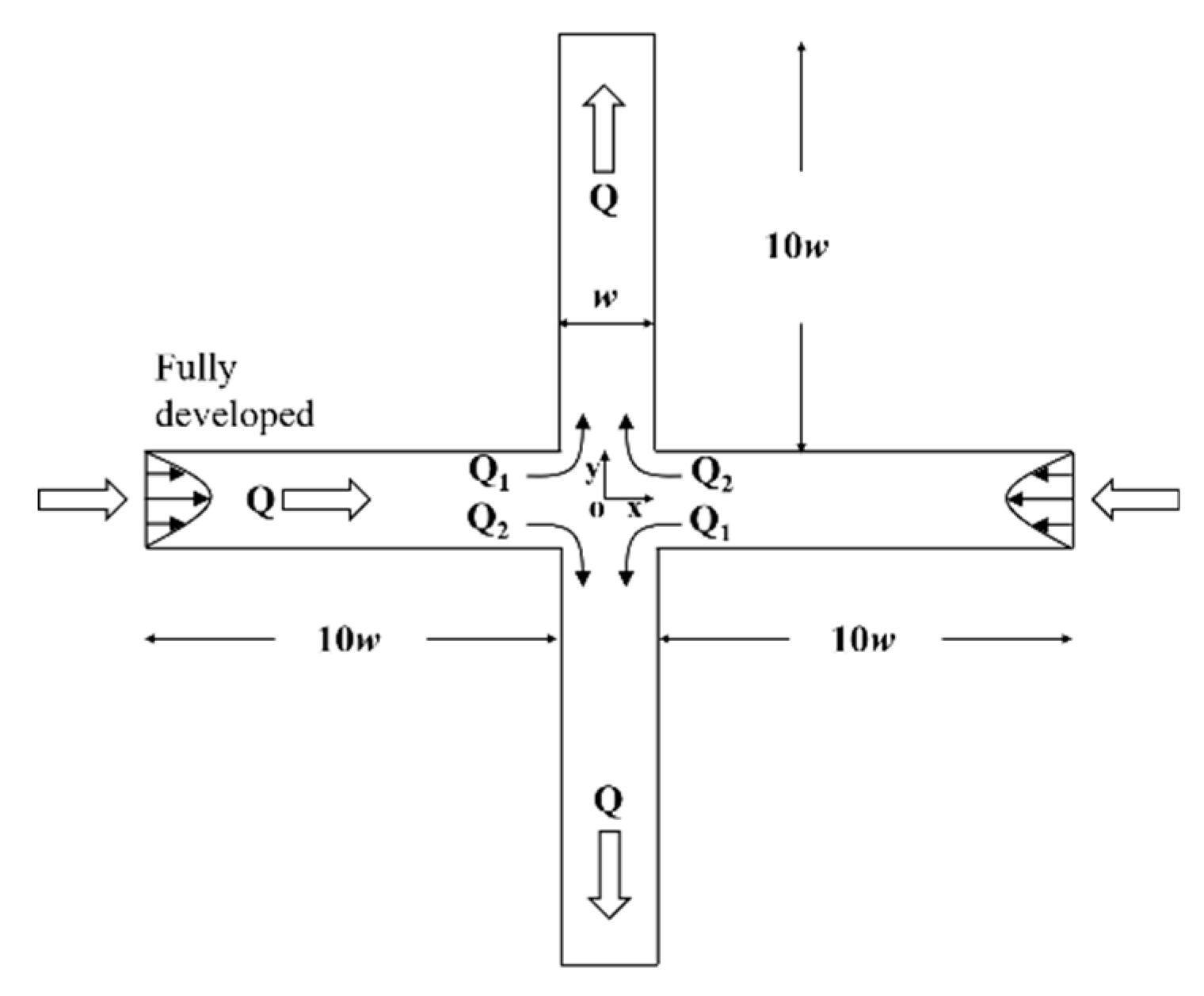
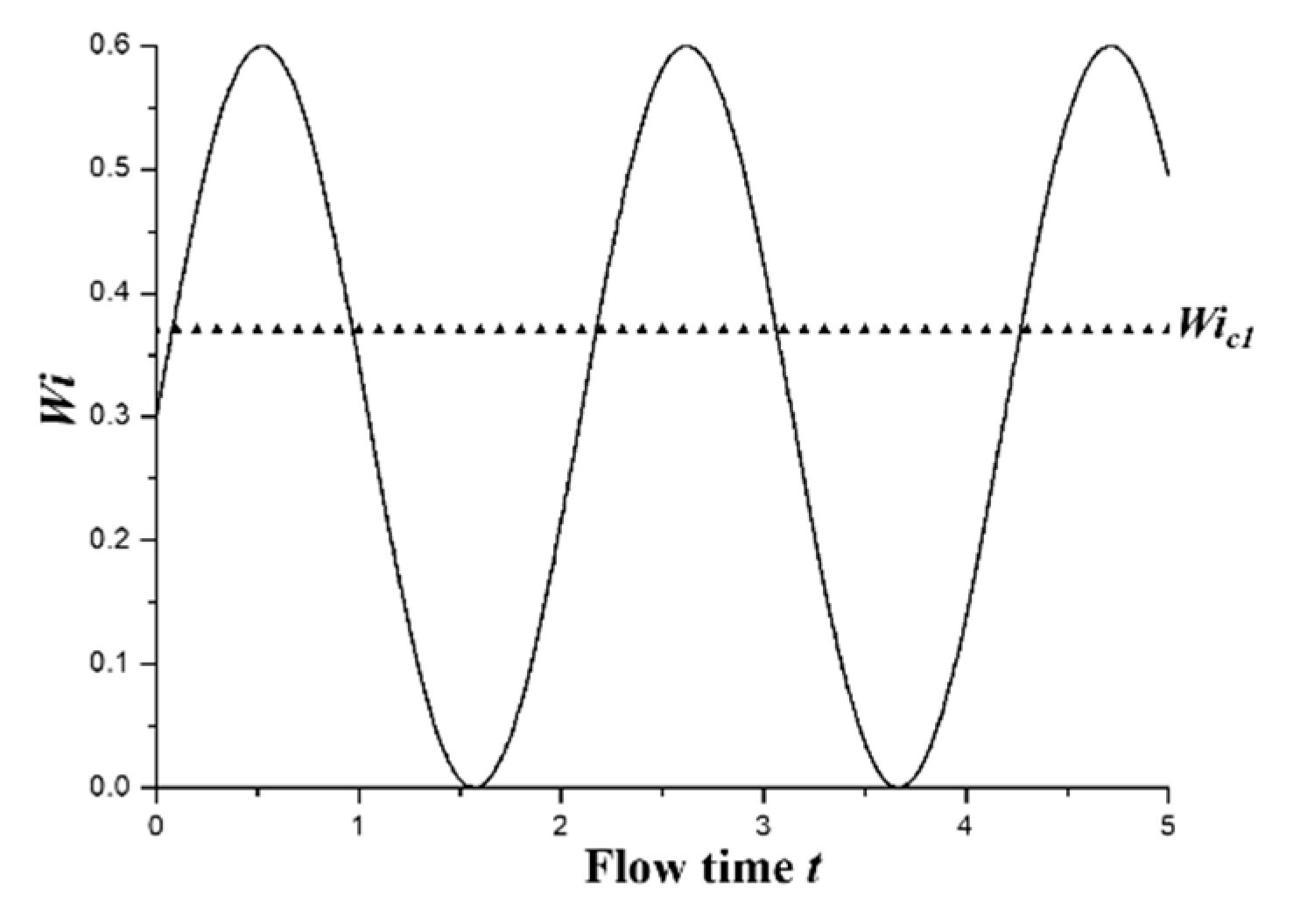
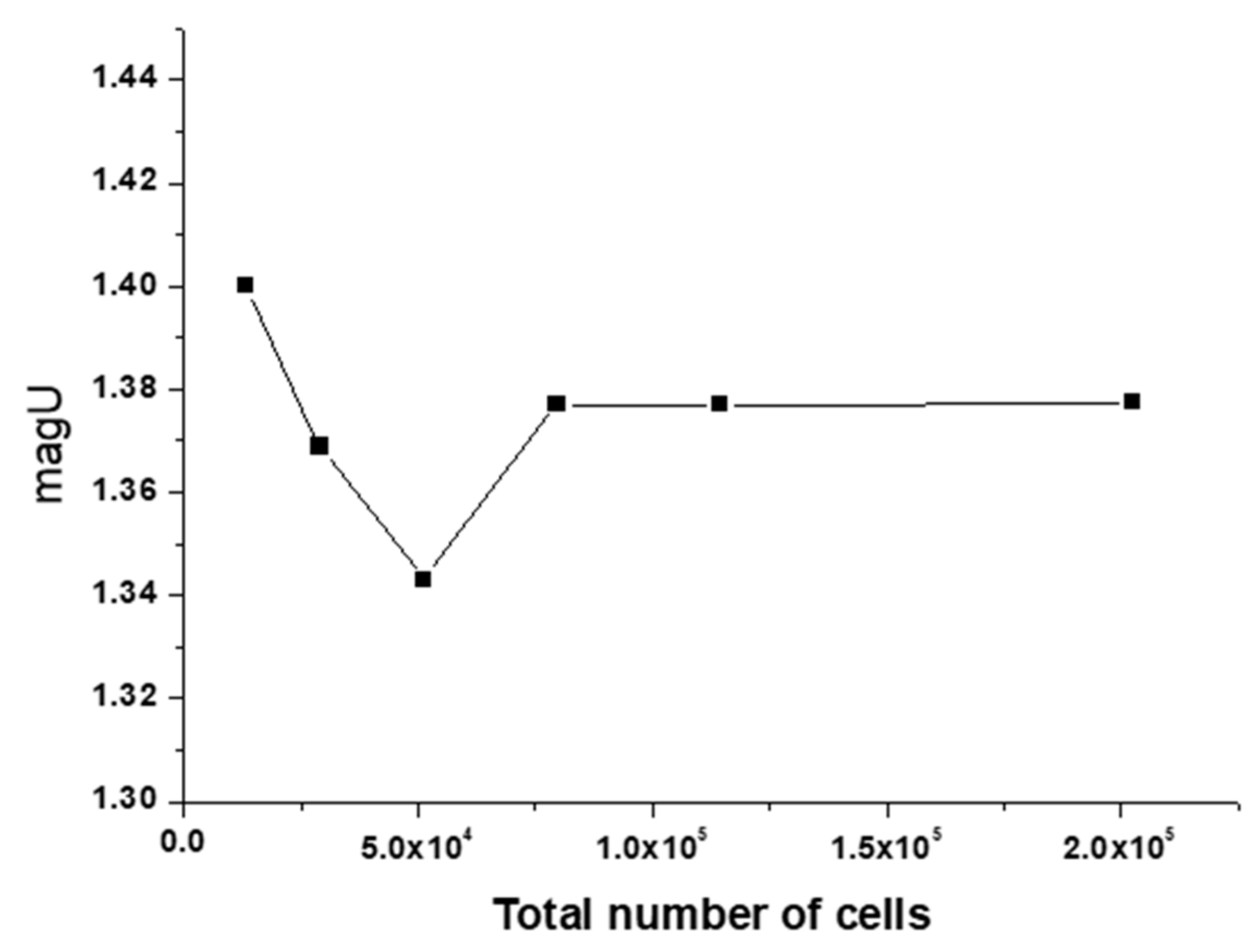
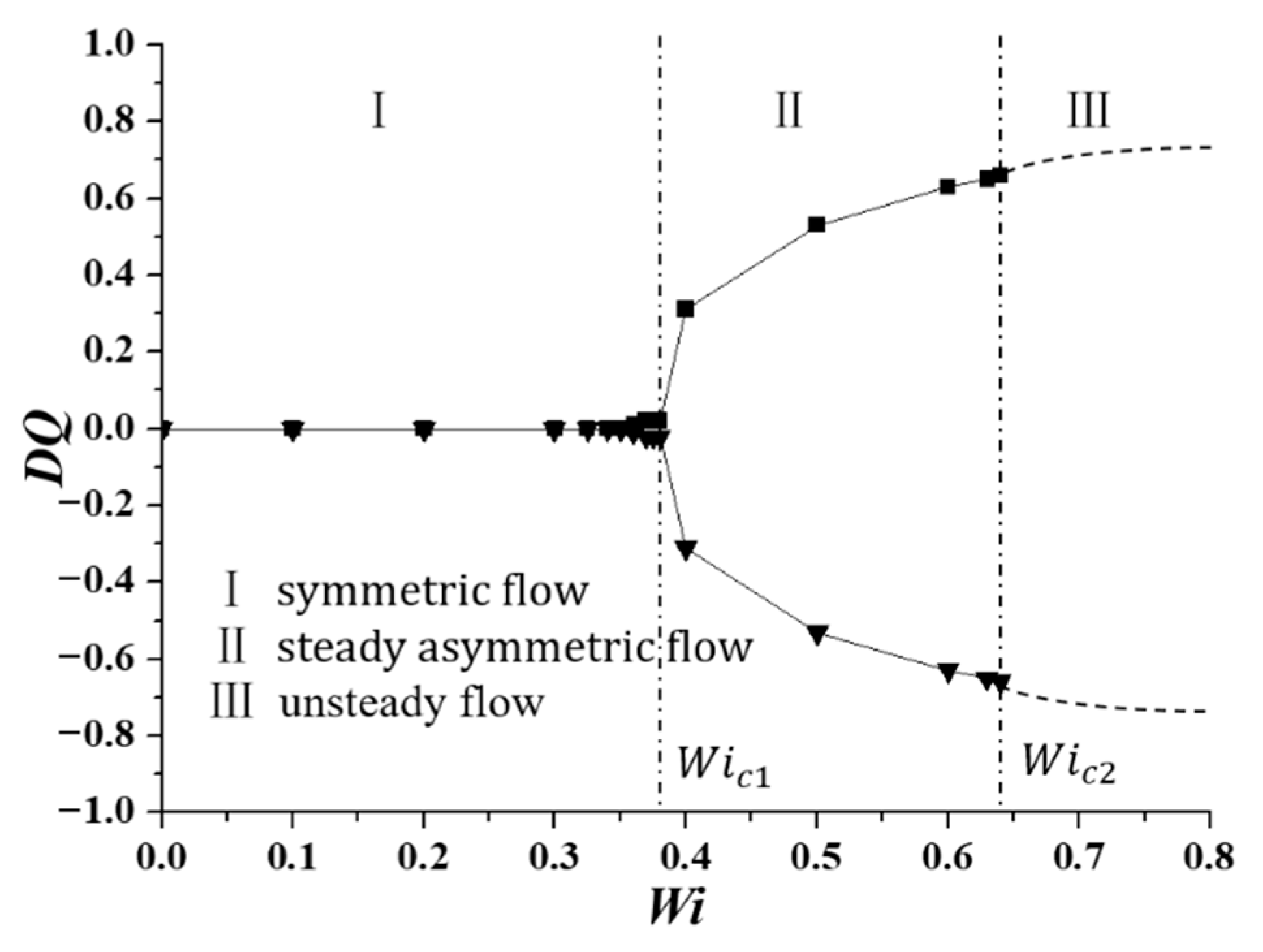

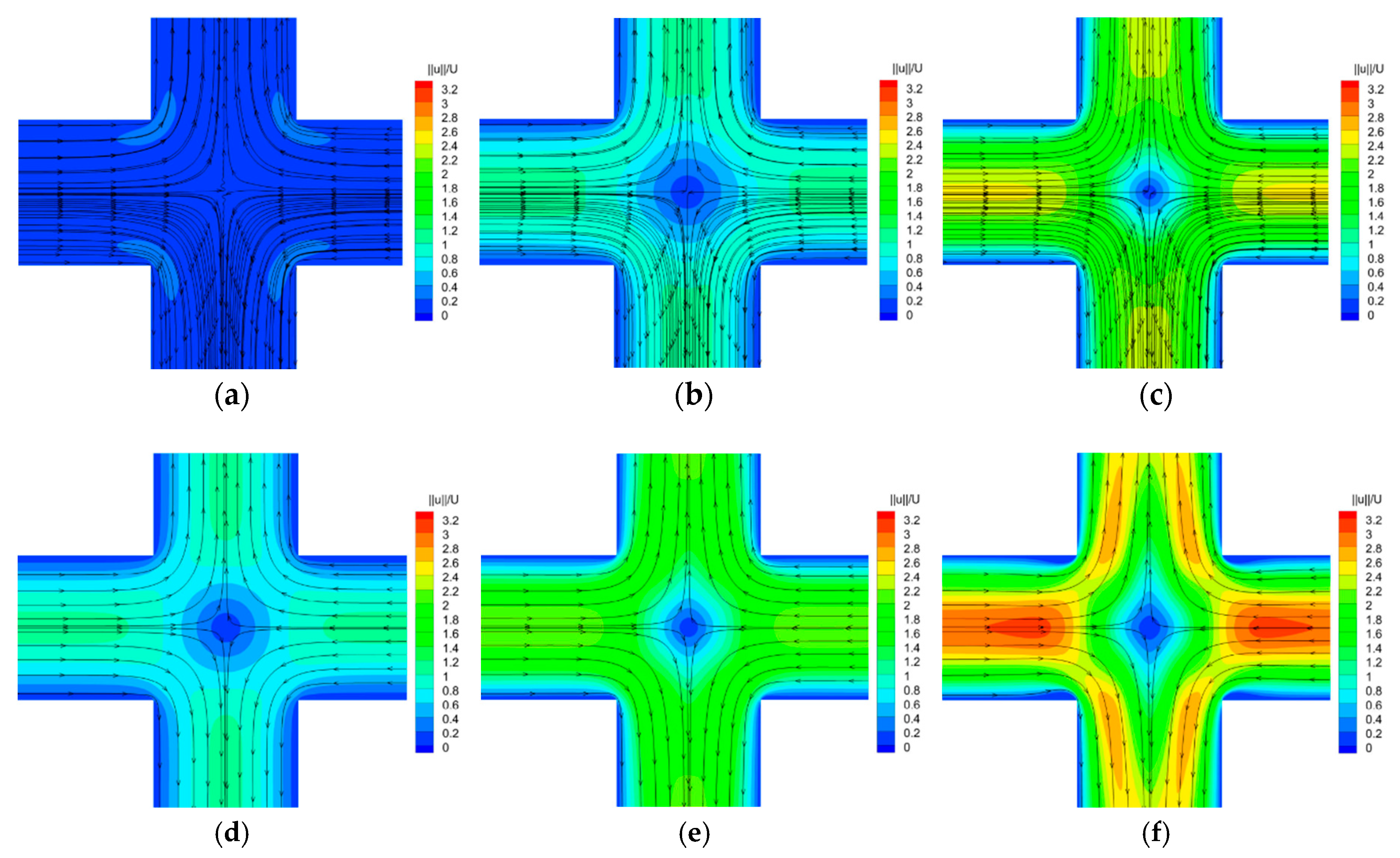
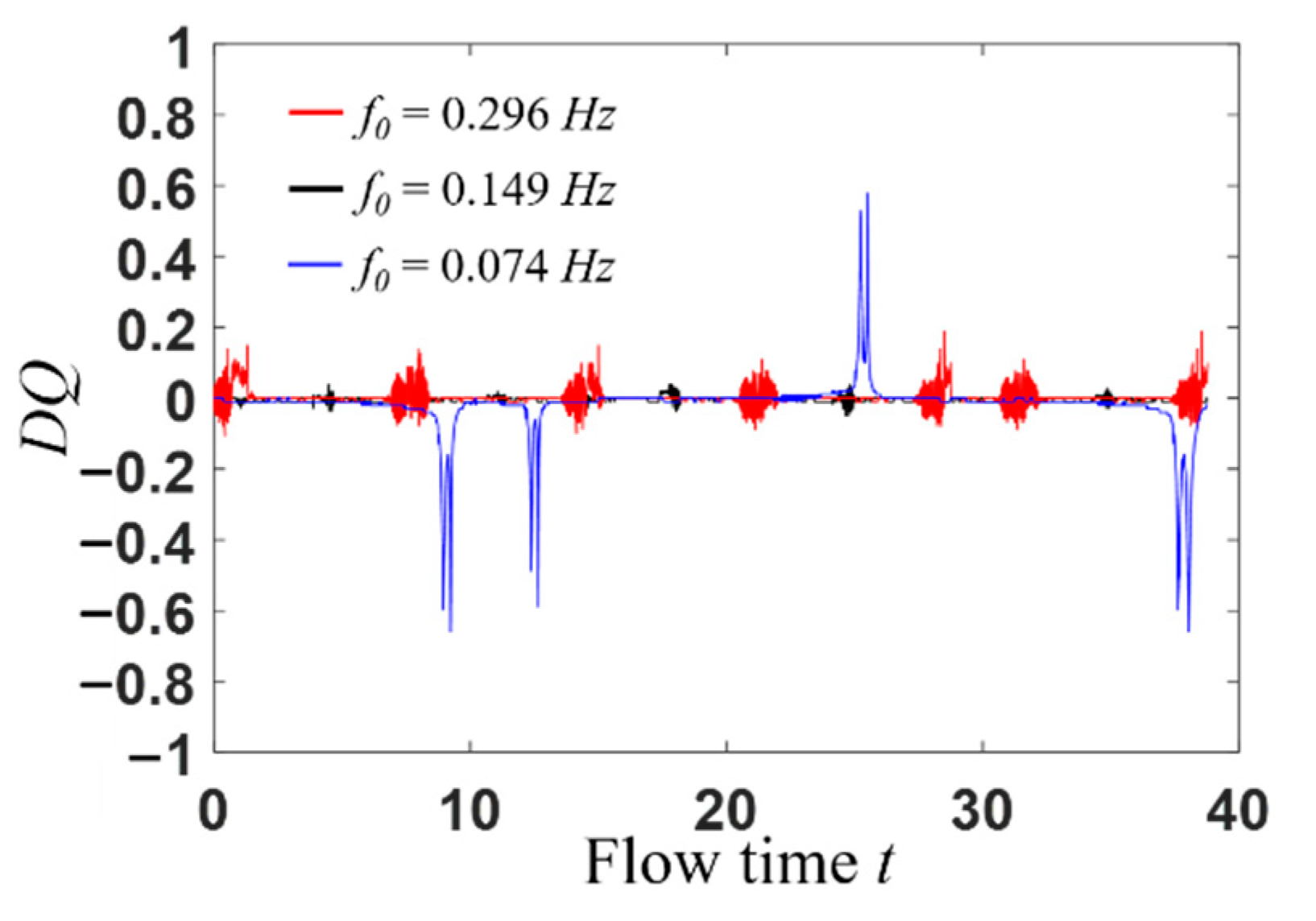






| f0 | U | A | λ |
|---|---|---|---|
| 0.296 | 1 | 1 | 0.3 |
| 0.149 | 1 | 1 | 0.3 |
| 0.074 | 1 | 1 | 0.3 |
| Item | NDx | NDy | NDbranch | NC | ND |
|---|---|---|---|---|---|
| Mesh1 | 51 | 51 | 51 | 13,112 | 12,801 |
| Mesh2 | 76 | 76 | 76 | 29,037 | 28,576 |
| Mesh3 | 101 | 101 | 101 | 51,212 | 50,601 |
| Mesh4 | 126 | 126 | 126 | 79,637 | 78,876 |
| Mesh5 | 151 | 151 | 151 | 114,312 | 113,401 |
| Mesh6 | 201 | 201 | 201 | 202,412 | 201,201 |
© 2020 by the authors. Licensee MDPI, Basel, Switzerland. This article is an open access article distributed under the terms and conditions of the Creative Commons Attribution (CC BY) license (http://creativecommons.org/licenses/by/4.0/).
Share and Cite
Yuan, C.; Zhang, H.-N.; Chen, L.-X.; Zhao, J.-L.; Li, X.-B.; Li, F.-C. Numerical Study on the Characteristics of Boger Type Viscoelastic Fluid Flow in a Micro Cross-Slot under Sinusoidal Stimulation. Entropy 2020, 22, 64. https://doi.org/10.3390/e22010064
Yuan C, Zhang H-N, Chen L-X, Zhao J-L, Li X-B, Li F-C. Numerical Study on the Characteristics of Boger Type Viscoelastic Fluid Flow in a Micro Cross-Slot under Sinusoidal Stimulation. Entropy. 2020; 22(1):64. https://doi.org/10.3390/e22010064
Chicago/Turabian StyleYuan, Chao, Hong-Na Zhang, Li-Xia Chen, Jun-Long Zhao, Xiao-Bin Li, and Feng-Chen Li. 2020. "Numerical Study on the Characteristics of Boger Type Viscoelastic Fluid Flow in a Micro Cross-Slot under Sinusoidal Stimulation" Entropy 22, no. 1: 64. https://doi.org/10.3390/e22010064
APA StyleYuan, C., Zhang, H.-N., Chen, L.-X., Zhao, J.-L., Li, X.-B., & Li, F.-C. (2020). Numerical Study on the Characteristics of Boger Type Viscoelastic Fluid Flow in a Micro Cross-Slot under Sinusoidal Stimulation. Entropy, 22(1), 64. https://doi.org/10.3390/e22010064





